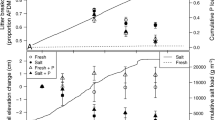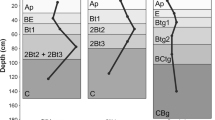Abstract
Plants, by influencing water fluxes across the ecosystem–vadose zone–aquifer continuum, can leave an imprint on salt accumulation and distribution patterns. We explored how the conversion of native grasslands to oak plantations affected the abundance and distribution of salts on soils and groundwater through changes in the water balance in naturally salt-affected landscapes of Hortobagy (Hungary), a region where artificial drainage performed ∼150 years ago lowered the water table (from −2 to −5 m) decoupling it from the surface ecosystem. Paired soil sampling and detailed soil conductivity transects revealed consistently different salt distribution patterns between grasslands and plantations, with shallow salinity losses and deep salinity gains accompanying tree establishment. Salts accumulated in the upper soil layers during pre-drainage times have remained in drained grasslands but have been flushed away under tree plantations (65 and 83% loss of chloride and sodium, respectively, in the 0 to −0.5 m depth range) as a result of a five- to 25-fold increase in infiltration rates detected under plantations. At greater depth, closer to the current water table level, the salt balance was reversed, with tree plantations gaining 2.5 kg sodium chloride m−2 down to 6 m depth, resulting from groundwater uptake and salt exclusion by tree roots in the capillary fringe. Diurnal water table fluctuations, detected in a plantation stand but not in the neighbouring grasslands, together with salt mass balances suggest that trees consumed ∼380 mm groundwater per year, re-establishing the discharge regime and leading to higher salt accumulation rates than those interrupted by regional drainage practices more than a century ago. The strong influences of vegetation changes on water dynamics can have cascading consequences on salt accumulation and distribution, and a broad ecohydrological perspective that explicitly considers vegetation–groundwater links is needed to anticipate and manage them.








Similar content being viewed by others
References
Ábrahám L, Bocskai J (1971) The utilization and amelioration of Solonetz soils in Hungary. In: Szabolcs I (ed) European solonetz soils and their reclamation. Akadémiami Kiado, Budapest, pp 61–97
Ahuja LR, El-Swaify SA, Rahman A (1976) Measuring hydrologic properties of soil with a double-ring infiltrometer and multiple-depth tensiometers. Soil Sci Soc Am J 40:494–499
Barret-Lennard EG (2002) Restoration of saline land through revegetation. Agric Water Manage 53:213–226
Bazilevich NI (1965) The geochemistry of soda soils. Jerusalem
Béla T (1972) Szikesek Fásítása (Afforestation on salt-affected soils). Akadémiai Kiadó, Budapest
Bouyoucos GJ (1962) Hydrometer method improved for making particle size analysis of soils. Agron J 54:464–465
Calder IR (1998) Water use by forests, limits and controls. Tree Physiol 18:625–631
Canadell J, Jackson RB, Ehleringer JR, Moones HA, Sala OE, Schulze ED (1996) Maximum rooting depth of vegetation types at the global scale. Oecologia 108:583–595
Culf AD, Allen SJ, Gash JHC, LLoyd CR, Wallace JS (1993) Energy and water budgets of an area of patterned woodland in the Sahel. Agric For Meteorol 66:65–80
Deuchards SA, Townend J, Aitkenhead MJ, Fitzpatrick EA (1999) Changes in soil structure and hydraulic properties in regenerating rain forest. Soil Use Manage 15:183–187
Devitt DA, Smith SD (2002) Root channel macropores enhance downward movement of water in a Mojave Desert ecosystem. J Arid Environ 50:99–108
Dunkerly D (2000) Hydrologic effects of dryland shrubs: defining the spatial extent of modified soil water uptake rates at an Australian desert site. J Arid Environ 45:159–172
Eldridge DJ, Freudenberger D (2005) Ecosystem wicks: woodland trees enhance water infiltration in a fragmented agricultural landscape in eastern Australia. Aust Ecol 30:336–347
Engel V, Jobbágy EG, Stieglitz M, Williams M, Jackson RB (2005) The hydrological consequences of Eucalyptus afforestation in the Argentine Pampas. Water Resourc Res 41:W10409, doi:10410.11029/12004WR003761
FAO (1991) World Soil Resources. An explanatory note on the FAO world soil resources map at 1:25.000.000 scale. Soil Resourc Rep 66. Food and Agriculture Organization, Rome
Farley KA, Jobbágy EG, Jackson RB (2005) Effects of afforestation on water yield: a global synthesis with implications for policy. Global Change Biol 11:1565–1576
Feng S, Hu Q, Qian W (2004) Quality control of daily meteorological data in China, 1951–2000: a new dataset. Int J Climatol 24:853–870
Frankenberger WT, Tabaitabai MA, Adriano DC, Doner HE (1996) Bromine, chlorine and fluorine. In: Sparks SL et al (eds) Methods of soil analysis—part 3 chemical methods. Soil Science Society of America, Madison, Wis., pp 883–868
Geary TF (2001) Afforestation in Uruguay—study of a changing landscape. J For 99:35–39
George RJ, McFarlane DJ, Nulsen RA (1997) Salinity threatens the viability of agriculture and ecosystems in Western Australia. Hydrogeol J 5:6–21
Grieve IC (1980) Some contrasts in soil development between grassland and deciduous woodland sites. J Soil Sci 31:137–145
Heuperman A (1999) Hydraulic gradient reversal by trees in shallow water table areas and repercussions for the sustainability of tree-growing systems. Agric Water Manage 39:153–167
Jackson RB, Canadell J, Ehleringer JR, Mooney HA, Sala OE, Schulze ED (1996) A global analysis of root distributions for terrestrial biomes. Oecologia 108:389–411
Jackson RB, Banner JL, Jobbagy EG, Pockman WT, Wall DH (2002) Ecosystem carbon loss with woody plant invasion of grasslands. Nature 418:623–626
Jenny H (1941) Factors of soil formation. McGraw-Hill, New York
Jobbágy EG, Jackson RB (2004) Groundwater use and salinization with grassland afforestation. Global Change Biol 10:1299–1312
Kelliher FM, Leuning R, Schulze ED (1993) Evaporation and canopy characteristics of coniferous forests and grasslands. Oecologia 95:153–163
Lavado RS, Taboada MA (1988) Water, salt and sodium dynamics in a natraquoll in Argentina. Catena 15:577–594
Loheide SPI, Butler JJJ, Gorelick SM (2005) Estimation of groundwater consumption by phreatophytes using diurnal water table fluctuations: a saturated-unsaturated flow assessment. Water Resour Res 41:W07030, doi:07010.01029/02005WR003942
Mishra A, Sharma SD (2003) Leguminous trees for the restoration of degraded sodic wasteland in eastern Uttar Pradesh, India. Land Degrad Dev 14:245–261
Mishra L, Mishra A, Sharma SD, Pandey R (2004) Amelioration of a highly alkaline soil by trees in northern India. Soil Use Manage 20:325–332
Morras H, Candioti L (1982) Relación entre permeabilidad, ciertos caracteres analíticos y situación topográfica de algunos suelos de los bajos submeridionales (Santa Fé). Rev Invest Agro 26:23–32
Munzbergova Z, Ward D (2002) Acacia trees as keystone species in Negev desert ecosystems. J Veg Sci 13:227–231
Nosetto M, Jobbágy EG, Paruelo JM (2005) Land use change and water losses: the case of grassland afforestation across a soil textural gradient in Central Argentina. Global Change Biol 11:1101–1117
Pickett STA (1989) Space-for-time substitution of as an alternative to long-term studies. In: Likens GE (ed) Long-term studies in ecology: approaches and alternatives. Springer, Berlin Heidelberg New York, pp 110–135
Schofield R, Thomas DSG, Kirby MJ (2001) Causal processes of soil salinization in Tunisia, Spain and Hungary. Land Degrad Dev 12:163–181
Scanlon BR, Reedy RC, Stonestrom DA, Prudic DE, Dennehy KF (2005) Impact of land use and land cover change on groundwater recharge and quality in the southwestern US. Global Change Biol 11:1577–1593
Sizemskaya ML, Romanenkov VA (1992) The evaluation of the desalinization rate of Solonchakous Solonetzes in ther Northern Caspian region under agroforestry practice. Pochvovedenie 6:83–91
Stefanovits P (1981) Mezögazdasági Kiadó (Soil science). Budapest
Szabolcs I (1979) Review of research on salt-affected soils. UNESCO, Paris
Szabolcs I (1989) Salt-affected soils. CRC, Fla.
Taboada MA, Lavado RS (1988) Grazing effects of the bulk density in a Natraquoll of the flooding Pampa of Argentina. J Range Manage 41:500–503
Talibudeen O (1991) Ion-selective electrodes. In: Smith KA (ed) Soil analysis. Modern instrumental techniques, vol 3, 2 edn. Dekker, New York, pp 111–182
Thomas GW (1996) Soil acidity and soil pH. In: Sparks SL, Page AL, Helmke PA, Loeppert RH, Soltanpour PN, Tabaitabai MA (eds) Methods of soil analysis—part 3 chemical methods. Soil Science Society of America, Madison, Wis., pp 475–490
Toth T, Rajkai K (1994) Soil and plant correlations in a solonetzic grassland. Soil Sci 157:253–262
Toth T, Csillag F, Biehl LL, Michéli E (1991) Characterization of Semivegetated salt-affected soils by means of field remote sensing. Remote Sens Environ 37:167–180
Walker GR (1998) Using soil water tracers to estimate recharge. In: Zhang L, Walker GR (eds) Studies in catchment hydrology. The basics of recharge and discharge. CSIRO, Collingwood
White WN (1932) A method of estimating groundwater supplies based on discharge by plants and evaporation from soil. In: USGS water-supply paper 659-A. USGS, Washington, D.C.
Williams DE (1948) A rapid manometric method for the determination of carbonate in soils. Soil Sci Soc Am Proc 13:127–129
Wood WE (1924) Increase of salt in soil and streams following the destruction of native vegetation. J R Soc West Aust 10:35–47
Wright JA, DiNicola A, Gaitan E (2000) Latin American forest plantations—opportunities for carbon sequestration, economic development and financial returns. J For 98:20–23
Acknowledgements
This research was supported by grants from SECYT (Argentina) and NKTH (Hungary) and the Inter-American Institute for Global Change Research (IAI, CRN II 2031), which is supported by the US National Science Foundation (grant GEO-0452325). Very helpful field assistance was provided by Klára Treczker and János Rásó. Special thanks to Imre Csiha and many people from the Experimental Station for Tree Planting on Alkali Land at Püspökladány for their hospitality and generosity. Ana Acosta and Silvina Ballesteros assisted us with the laboratory work. We thank Marisa Puente for her suggestions to improve this manuscript. M. Nosetto was supported by CONICET (Beca Doctoral Interna).
Author information
Authors and Affiliations
Corresponding author
Additional information
Communicated by Russell Monson.
Rights and permissions
About this article
Cite this article
Nosetto, M.D., Jobbágy, E.G., Tóth, T. et al. The effects of tree establishment on water and salt dynamics in naturally salt-affected grasslands. Oecologia 152, 695–705 (2007). https://doi.org/10.1007/s00442-007-0694-2
Received:
Accepted:
Published:
Issue Date:
DOI: https://doi.org/10.1007/s00442-007-0694-2




